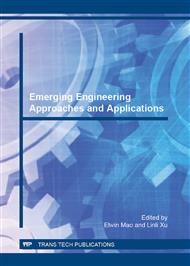[1]
L. Mogi, Active periods in the world's chief seismic belts. Tectonophysics, 22(1974)265-282.
DOI: 10.1016/0040-1951(74)90086-9
Google Scholar
[2]
Z.J. Ma, The global seism tectonic systems, Earth Science-Journal of Wuhan College of Geology, 18(3) (1982)23-38.
Google Scholar
[3]
G.M. Zhang, L. Li, Scientific Thought of Prediction of Earthquake and Trend in the Coming Years in China, In: Center of analysis and prediction of China Seismological Bureau, Study earthquake trend in China(1998).
Google Scholar
[4]
G.M. Zhang, J. Liu, Y. L Shi, An scientific evaluation of annual earthquake prediction ability, Acta Seismologica Sinica, 15(5) (2002)550-558.
DOI: 10.1007/s11589-002-0024-z
Google Scholar
[5]
Z.X. Fu, J. Liu, G. P. Liu, Three Division Method of Clustering Strong Earthquake Activity in China's Continent and its Application, Earthquake, 20(2000)Sup. 34-37 (in Chinese).
Google Scholar
[6]
H.C. Shao, C.E. Du, Z.H. Liu, Y.X. Sun, C.Q. Xia, Multi-scale analysis of earthquake activity in Chinese mainland, Acta Seismologica Sinica, 17(1) (2004)109-113.
DOI: 10.1007/bf03191401
Google Scholar
[7]
H. C. Shao, X.X. Du, X.S. Jin, C.E. Du. The Application of the Wavelet Analysis in Earthquake Prediction, Earthqyake Research in China, 16(1) (2000)48-52(in Chinese).
Google Scholar
[8]
T.Z. Liu, P.P. Rong, S.D. Liu. et al. Wavelet Analysis of Climate Jump, Chinese J. of Geophysics, 38(2)(1995)158-162(in Chinese).
Google Scholar
[9]
F.S. Yang, Analysis and Application of Wavelet Transformation in Engine, Beijing: Science Press, 2001(in Chinese).
Google Scholar
[10]
J.P. Laura, D.N. David, Wavelet Analysis of Velocity Dispersion of Elastic Interface Waves Propagating Along a Fracture. Geophys Res Lett, 22(11) (1995)1329-1332.
DOI: 10.1029/95gl01323
Google Scholar
[11]
Y.X. Xu, J.Y. Wang, Power Spectrum Estimation for Magnetotelluric Signal Based on Continuous Wavelet Transform, Chinese J. of Geophysics 43(5)(2000)677-683(in Chinese).
DOI: 10.1002/cjg2.86
Google Scholar
[12]
X.X. Du, Wavelet-based Analysis of Dynamic Seismicity Period, Earthqyake, 17(3)(1997) 257-264(in Chinese).
Google Scholar
[13]
Z.X. Fu, H.C. Shao, X. Ding, Relation between distribution of shallow strong earthquake in china's continent and the earth rotation rate variation, Earthquake, 24(3)(2004)15-20(in Chinese).
Google Scholar
[14]
W.J. Bo, G.Y. Wang, Research on relations among earthquake rotation, Fault deformation and seismicity, Journal of Geodesy and Geodynamics, 26(2)(2007)43-47(in Chinese).
Google Scholar


